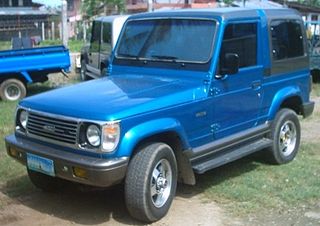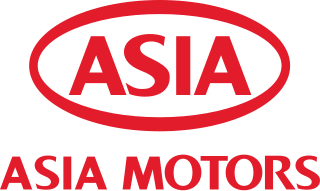
Jeep is an American automobile marque, now owned by multi-national corporation Stellantis. Jeep has been part of Chrysler since 1987, when Chrysler acquired the Jeep brand, along with other assets, from their previous owner American Motors Corporation (AMC).

The Ford Festiva is a subcompact car that was designed and manufactured by Mazda for Ford between 1986 and 2002. Festiva was sold in Japan, the Americas, and Australia. The name "Festiva" is derived from the Spanish word for "festive". It was not related to the similarly sized and named Ford Fiesta, and was not replaced by the Ford Ka, which is smaller.

The Kia Sportage is a series of automobiles manufactured by the South Korean manufacturer Kia since 1993 through five generations. Initially a compact SUV built on a body-on-frame chassis, the second-generation Sportage transitioned to a car-based platform which placed it into the compact crossover SUV class, and has been developed alongside the Hyundai Tucson. Since the fifth-generation model launched in 2021, Kia developed the Sportage in two sizes with different wheelbase lengths for different markets.

The Mazda Sentia is a mid-size rear wheel drive luxury car that was sold by Mazda in Japan from 1991 to 1999 over two generations. It replaced the Mazda Luce nameplate on the Mazda H platform, and continued the tradition of being Mazda's largest flagship sedan, which had been in production since the late 1960s.

The Asia Rocsta is a four-wheel drive off-road vehicle built by Asia Motors Corporation in South Korea. It was available as a Jeep or Pick-up Truck.

Asia Motors Industries, traded as Asia Motors, was a South Korean car manufacturer established in 1965 and closed in 1999. From 1976 onwards, it was a subsidiary of Kia Motors.

The Kia Carnival is a minivan manufactured by Kia since 1998. It is marketed globally under various nameplates, prominently as the Kia Sedona.

The Kia Picanto is a city car that has been produced by the South Korean car manufacturer, Kia, since 2003. Other names of the car include Kia Morning in South Korea, Hong Kong, Taiwan and Chile, Kia EuroStar in Taiwan, Kia New Morning in Vietnam and the Naza Suria or Naza Picanto in Malaysia. The Picanto is primarily manufactured at the Donghee joint-venture plant in Seosan, South Korea, though some countries locally assemble complete knock-down versions of the car.

The SsangYong Korando is a mini SUV or compact crossover SUV built by the South Korean automobile manufacturer SsangYong from 1983 to 2006 and from 2010 onwards. The name Korando is a contraction of "Korea Can Do". The Korando brand is listed in the Guinness Book of Records as Korea’s longest surviving name plate.

Daewoo Precision Industries K2 assault rifle is the standard service rifle of the South Korean military. It was developed by the South Korean Agency for Defense Development and manufactured by SNT Motiv and Dasan Machineries. Shoulder-fired and gas-operated, the K2 is capable of firing both 5.56×45mm NATO and .223 Remington ammunition; however, using .223 Remington is only recommended for practicing for short distance.

The M101A1 howitzer is an artillery piece developed and used by the United States. It was the standard U.S. light field howitzer in World War II and saw action in both the European and Pacific theaters and during the Korean War. Entering production in 1941, it quickly gained a reputation for accuracy and a powerful punch. The M101A1 fires 105 mm high explosive (HE) semi-fixed ammunition and has a range of 12,330 yards (11,270 m), making it suitable for supporting infantry.

The BA-64 was a Soviet four-wheeled armoured scout car. Built on the chassis of a GAZ-64 or GAZ-67 jeep, it incorporated a hull loosely modeled after that of the Sd.Kfz. 221. The BA-64 was developed between July and November 1941 to replace the BA-20 then in service with armoured car units of the Red Army. Cheap and exceptionally reliable, it would later become the most common Soviet wheeled armoured fighting vehicle to enter service during World War II, with over 9,000 being manufactured before production ended.

The Willys MB and the Ford GPW, both formally called the U.S. Army Truck, 1⁄4‑ton, 4×4, Command Reconnaissance, commonly known as the Willys Jeep, Jeep, or jeep, and sometimes referred to by its Standard Army vehicle supply nr. G-503, were highly successful American off-road capable, light military utility vehicles. Well over 600,000 were built to a single standardized design, for the United States and the Allied forces in World War II, from 1941 until 1945. This also made it the world's first mass-produced four-wheel-drive car, built in six-figure numbers.
North Korea's defence industry predates the Korean War, but has emerged as a major supplier to the North Korean armed forces beginning in the 1970s, but increasingly so after the fall of the Soviet Union and to supplement those purchased from China. Most equipment produced are copies of Soviet and Chinese built military hardware.

The Bangtan Helmet is a combat helmet developed by South Korea in 1971. Despite the name, the helmet was not designed to withstand against direct hitting bullets but to protect against heavy objects and bomb shrapnel–a standard for 1970s military world wide; though, it was one of the earliest military helmets that applied non-metal composite material to reduce the weight while increasing the protection. The name was given as a commemorate for being superior than the M1 helmet. The helmet configuration is based on the latest version of the M1.

The automotive industry in South Korea is the fifth-largest in the world as measured by automobile unit production and also the sixth-largest by automobile export volume.

The S&T Motiv K14 is a .308 Winchester bolt-action sniper rifle developed by S&T Motiv, and is the standard sniper rifle of the Republic of Korea Armed Forces.

The K311 is a 4x4 multipurpose 1 1/4–ton class cargo truck developed for the Republic of Korea Armed Forces, and was introduced in 1980. It is commonly known as 4-5 (5/4) ton or military Dodge, because it replaced and had similar appearance with Dodge M37. It is a modernized version of the American Kaiser Jeep M715 truck, which was also designed with an intention to replace the M37 truck.
The K100 "Jeep" is a 4x4 1/4-ton multi-purpose truck developed by American Motors Corporation and Shinjin Jeep Motor Company for the Republic of Korea Armed Forces in 1974. The K100 joined the armed forces in 1975 and was produced as a gap-filler until the start of mass production of the K111 Jeep in 1978.

















